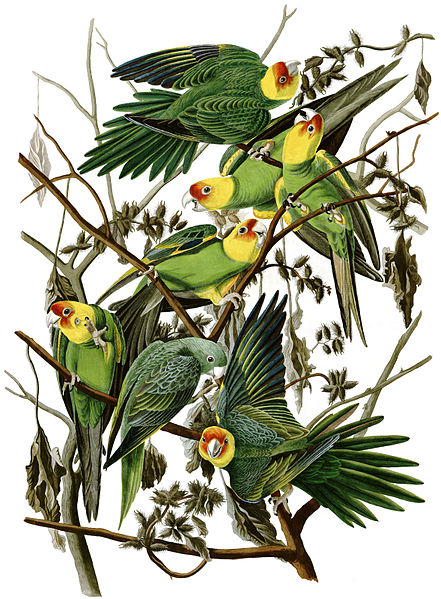 I’ve been involved in a number of field research efforts, and so am somewhat familiar with the difficulties inherent in funding and implementing conservation work. However, I must admit that this situation is baffling – a recovery plan has not yet been formulated for the Thick Billed Parrot (Rhynchopsitta pachyrhyncha), despite the fact that the bird has been protected by the Endangered Species Act since the law’s inception in 1973!
I’ve been involved in a number of field research efforts, and so am somewhat familiar with the difficulties inherent in funding and implementing conservation work. However, I must admit that this situation is baffling – a recovery plan has not yet been formulated for the Thick Billed Parrot (Rhynchopsitta pachyrhyncha), despite the fact that the bird has been protected by the Endangered Species Act since the law’s inception in 1973!
Help for the US’s Last Native Parrot?
The Thick Billed Parrot is the only remaining Psittacine native to the US Mainland. The other, the Carolina Parakeet, was hunted to extinction in the early 1900’s. With less than 3,000 individuals surviving in the wild, this green and red parrot may be headed for a similar fate if remedial action is not undertaken soon.
To that end, the conservation organization WildEarth Guardians has filed suit against Secretary of the Interior Ken Salazar, seeking to compel the implementation of a recovery plan. Let’s hope for a “parrot-friendly” outcome!
Wild and Captive Status
 Thick Billed Parrots regularly ranged into central Arizona and New Mexico until the early 1900’s, and sporadically until the mid 1960’s. Today they are virtually unknown within US borders. A reintroduction plan instituted by the state of Arizona was not successful.
Thick Billed Parrots regularly ranged into central Arizona and New Mexico until the early 1900’s, and sporadically until the mid 1960’s. Today they are virtually unknown within US borders. A reintroduction plan instituted by the state of Arizona was not successful.
Although far from common in captivity, the birds do breed well when properly provided for… a group I’ve watched for years is a star attraction at the Queens Zoo in New York City. Private keepers have had some success with this species as well, and even provided several of the individuals released in Arizona.
Further Reading
Please see The USA’s “Other” Parrot for more information on this fascinating bird (it forages in the snow!).
Please visit the WildEarth Guardians Website for more on the group’s work with Parrots, Jaguarundis, Tortoises and other animals.
Thick-billed Parrots image referenced from wikipedia and originally posted by Paul Reynolds and Snowmanradio
 That Bird Blog – Bird Care and History for Pet Birds
That Bird Blog – Bird Care and History for Pet Birds

 The region extending from New Zealand northwest through Australia to New Guinea and the islands of Indonesia is home to the world’s greatest diversity of parrots, with over one half of the known genera represented. Conservation efforts are most effective in Australia and New Zealand, but less in evidence in New Guinea and islands in the Southwest Pacific.
The region extending from New Zealand northwest through Australia to New Guinea and the islands of Indonesia is home to the world’s greatest diversity of parrots, with over one half of the known genera represented. Conservation efforts are most effective in Australia and New Zealand, but less in evidence in New Guinea and islands in the Southwest Pacific. Habitat loss and alteration is the gravest threats facing Australia’s parrots. The felling of old trees bearing suitable hollows for nesting is particularly serious, as many parrots have specific requirements as to the size, height and location of nesting hollows, and will not utilize alternatives. Especially hard hit have been Baudin’s, Carnaby’s and Mitchell’s Cockatoos, but most others are affected as well.
Habitat loss and alteration is the gravest threats facing Australia’s parrots. The felling of old trees bearing suitable hollows for nesting is particularly serious, as many parrots have specific requirements as to the size, height and location of nesting hollows, and will not utilize alternatives. Especially hard hit have been Baudin’s, Carnaby’s and Mitchell’s Cockatoos, but most others are affected as well.